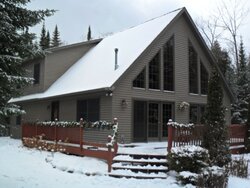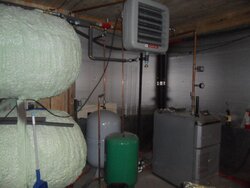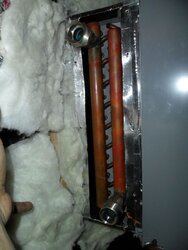When comparing Radiant panels or cast iron radiators to Forced air heat do your heat loss numbers stay the same? I guess I am curious because of all the positive feedback I see here about Panel radiators and cast iron radiators. Does wood use decline if using radiators vs Forced air heat exchanger?
I'm not sure you are asking the right question, but let me take a guess at what you want to find out. For space heating, I think the question might be what type of heat delivery system provides the most human comfort from the least amount of energy delivered to the heat emitters (forced air fan coil, radiant panel, fin-tube, in-floor radiant, etc.)?
From an energy perspective, 1 btu = 1 btu no matter what delivery system is used. From a comfort perspective most people would agree that when heat is needed for human comfort, forced air needs to be quite warm to produce a feeling of warmth because moving air also accelerates evaporation of moisture from the skin, and evaporation has a cooling effect. The slower the moving air, the less evaporative cooling effect. I'm going to take a guess that from a thermometer in the heated room perspective, moving air that heats the space to 72F will take the same amount of btu's that any other heat emitter system will use to heat the thermometer to 72F (unless the thermometer is in the direct radiance of a radiant heat source greater than 72F).
Evaporative cooling aside, I think also most people would agree that a lower temperature radiant source feels warmer than a higher temperature air source, and therefore the room may be heated to a thermometer temperature of less than 72F, resulting in less btu input into the room. If the radiant heat source is greater than 72F, then I think the reason is that radiant energy greater than 72F is striking the skin and heating the skin (and other surfaces) to more than 72F, therefore the skin is warmer than 72F, comfort is established, and the warmed surfaces by conductive and convective forces then may heat the room to 72F shown by the thermometer, or because the skin is warmer than 72F, the room temperature comfortably may be established at something lower than 72F, resulting in a need for less btu input into the room.
If less btu input into the room is needed, then heat energy from wood or any other source may decline.
I'm also going to guess that the slower the moving air from a forced air heat source, the lower the temperature of the air needs to be to achieve a comfort level. In other words, a large volume of low velocity warm moving air probably can be at a lower temperature than smaller volumes of higher velocity and higher temperature moving air. In my experience higher velocity and higher temperature moving air would be typical for a house.
Another factor is the needed btuh rating of the heat source. An intermittent source, such as a typical forced air furnace or unit, needs to have a higher btuh rating than a more constant source, such as low temperature radiant emitters. The reason is simple. If building heat loss is 30,000 btuh, that applies regardless of the heat source, But if the heat source is forced air that is "on" only 1/3 the time, then the forced air source must have an output of 90,000 btuh. But a low temperature emitter that is constant would only need to have an output of 30,000 btuh.
This is where wood gasification boiler systems with storage excel. These systems can use the high and efficient energy output of burning wood to the maximum and then deliver the btu's constantly from storage.




